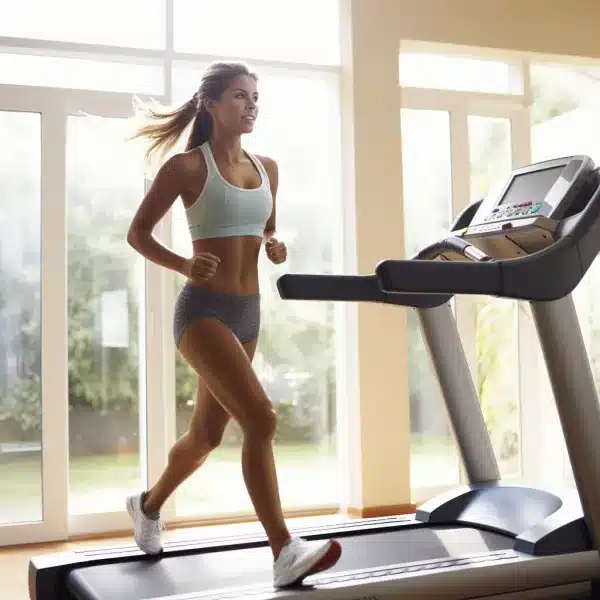Introduction
How Much Does a Treadmill Weigh: Treadmills are practical and effective cardiovascular workout machines that promote health. Treadmill weight varies by kind, brand, and amenities. Treadmills typically weigh 150 pounds (68 kilograms) for compact and lightweight models and over 300 pounds (136 kilograms) for commercial or high-end models. Treadmill weight depends on frame design, motor size, and extras like inclination mechanisms and built-in screens.
Setting up a treadmill or moving it for storage or transportation requires knowing its weight. Knowing these weight factors might help customers choose the correct walk treadmill for their fitness needs. Home and gym treadmills are essential to many workout routines. Treadmill weight is important for stability, long-term use, and practicality.
Weights vary by treadmill type and purpose. Small home treadmills weigh 150–200 pounds. These lightweight variants are easy to store and move, making them ideal for compact settings. However, commercial-grade treadmills can weigh above 300 pounds (136 kilograms) or 400 pounds (181 kilograms). These durable devices can sustain heavy use in crowded gyms and accommodate different-sized users.

How big is the average treadmill?
Common Treadmill Dimensions
Generally speaking, a treadmill is usually between 5 and 7 feet long and 2 to 3 feet wide. The height of the treadmill varies even more. Some machines, like under-desk treadmills, are just a few inches high, whereas others are 4 to 5 feet tall.
Compact and Folding Treadmills: Some treadmills are designed to save space. These can be folded up when not in use. When folded, their dimensions are significantly reduced, making them a good choice for those with limited space. These treadmills are typically around 6 to 7 feet long when in use, 2 to 3 feet wide, and around 5 to 6 feet high. When folded, they can be half the length or more.
Commercial Treadmills: Treadmills used in commercial gyms are generally larger and more robust. They can be up to 8 feet in length, 3 to 4 feet wide, and around 5 feet in height. They are much smaller in size, with dimensions of approximately 4 to 5 feet in length, 2 feet in width, and only a few inches in height.
Manual Treadmills: Manual treadmills are often smaller and more compact than motorized ones. They can be around 4 to 5 feet in length, 1.5 to 2 feet in width, and 4 to 5 feet in height. Their dimensions can vary depending on their intended use.
How much does a treadmill desk weigh?
UREVO under desk treadmill is only 4.2 inches thick and weighs 55lbs. Designed with two front mobile wheels, anyone can move it easily. You can easily store it under the bed, sofa or working desk, which can save your space perfectly.
Ultra-light Models: As mentioned, some treadmill desks are quite lightweight, around 55 pounds or even lighter. These might weigh closer to 100 pounds or more, especially if they are larger or come with features.
Motorized vs. Manual: The presence of a motor can significantly affect the weight of a treadmill desk. Motorized models tend to be heavier due to the motor and the associated components, while manual treadmill desks are generally lighter because they lack the motor. The materials used in construction can also impact the weight.
Compact and Folding Designs: Some treadmill desks are designed to be foldable, which can make them easier to move and store. Folding models are generally lighter because they need to be manageable when folded up. Treadmill desks with sturdy frames and higher-quality materials may be heavier, but they tend to be more durable.
How far is 30 minutes on the treadmill?
Your 30 minutes of formal exercise on the treadmill add up to about two miles, or around 4,000 steps. (Though the number of steps can vary depending on your stride and speed, one mile tends to be about 2,000 steps). So, you’ve got 6,000 more steps to go, or about another two to three miles.
Calories Burned: The number of calories burned during 30 minutes on a treadmill can vary based on factors like your weight, age, and exercise intensity. On average, a person weighing around 155 pounds may burn roughly 223 to 298 calories during 30 minutes of moderate-intensity treadmill exercise.
Speed and Incline: The speed and incline settings on the treadmill can significantly affect the distance you cover and the intensity of your workout. Increasing the speed or adding an incline will generally make the workout more challenging and increase the distance covered.
Fitness Level: Your fitness level plays a role in how far you can go in 30 minutes. Beginners may cover less distance than seasoned runners or walkers. As you progress in your fitness journey, you may be able to cover more ground in the same amount of time. Your workout goals also impact the distance you aim to cover in 30 minutes. Some people may focus on a particular distance, while others may aim for a certain duration of exercise, regardless of distance.
How strict are treadmill weight limits?
The weight limit offered by your treadmill will often depend on its quality and durability. Many lower-end treadmills have a limit of around 200 pounds, whereas higher-end treadmills, such as those by NordicTrack and Landice, are typically built to accommodate 300 to 500 pounds.
Quality and Price: As you lower-end or less expensive treadmills often have lower weight limits, typically around 200 to 250 pounds. These treadmills may not be as sturdy or durable as higher-end models. More expensive and higher-quality treadmills are often designed to accommodate higher weight limits. Treadmills from reputable brands like NordicTrack and Landice can have weight limits ranging from 300 to 500 pounds or even more.
Safety: Exceeding the weight limit of a treadmill can compromise its structural integrity and safety. It’s essential to adhere to the weight limit specified by the manufacturer to avoid potential safety hazards. When choosing a treadmill, it’s to consider not only your weight but also any variations due to different users. If multiple people will be using the treadmill, make sure the weight limit accommodates the heaviest user.
Warranty and Support: Higher-quality treadmills often come with better warranties and customer support. They are more likely to provide reliable performance over time, especially for users who are close to the weight limit. These treadmills are built to be more robust and durable.
Is it safe to use a treadmill daily?
Obviously distance and pace still factor, so if you are running hard for a long time every day you’re likely to be injured. But as far as using the treadmill daily in general, yes it’s safe.
Variety: To reduce the risk of overuse injuries, it’s a good idea to vary your workouts. Instead of running hard every day, mix in different types of exercise, such as walking, jogging, running, and strength training. This can help prevent strain on specific muscles and joints. Rest days are essential for preventing injuries.
Warm-Up and Cool-Down: Always start your treadmill workout with a proper warm-up and finish with a cool-down. This helps prepare your body for exercise and aids in recovery. Stretching and mobility exercises can also be helpful. Pay attention to any signs of overtraining or overuse injuries. If you experience persistent pain, discomfort, or fatigue, it’s give your body time to rest and recover.
Proper Footwear: Wear appropriate footwear that provides cushioning and support, especially if you’re using the treadmill regularly. This can help reduce the impact on your joints and minimize the risk of injuries. Not every workout needs to be high-intensity. You can adjust the speed, incline, and duration of your treadmill sessions to match your fitness level and goals.
Can I use the treadmill for 1 hour?
So if you have a big weight-loss, workout or other health goal, walking for one hour on the treadmill can get you closer without putting undue stress on your joints. But don’t stop there! The guidelines also recommend at least two, full-body, strength-training workouts a week.
Goal and Intensity: Walking on a treadmill for an hour is a great way to burn calories and improve your cardiovascular fitness. It’s especially effective for weight loss and overall health when combined with a balanced diet. The intensity at which you walk (e.g., speed and incline) can impact the effectiveness of your workout.
Pacing Yourself: If you’re not accustomed to walking for an hour, it’s essential to pace yourself and gradually increase the duration and intensity of your workouts. Start with a duration that’s comfortable for you, and over time, you can work your way up to a full hour.
Variety: To prevent monotony and reduce the risk of overuse injuries, consider incorporating variations in your treadmill routine. You can adjust the speed, incline, and even introduce short intervals of higher intensity (e.g., walking or jogging faster for a few minutes) to keep your workouts interesting and challenging.
Rest and Recovery: While using the treadmill for an hour can be an excellent workout, it’s allow your body to rest and recover. Incorporate rest days into your weekly routine to prevent overtraining and give your muscles and joints a chance to recuperate. Consider adding strength training exercises to your weekly schedule to build muscle and improve overall fitness.
Is it better to walk or run on a treadmill?
Weight loss is a numbers game—meaning you have to burn more calories than you consume—so from that perspective, running is more efficient than walking. On average, running a mile on the treadmill burned 33 more calories than walking, a study in Medicine & Science in Sports & Exercise found.
Recovery and Injury Prevention: Walking is often recommended as a form of active recovery for runners or individuals with high-impact exercise routines. It can help reduce the risk of overuse injuries. Walking is a more inclusive activity, suitable for individuals of all fitness levels and ages. It’s an excellent option for seniors and people with mobility issues.
Mental Relaxation: Walking at a comfortable pace can provide a relaxed, meditative experience, allowing you to clear your mind and reduce stress. If you have limited time for exercise, running allows you to get a more intense workout in a shorter amount of time.
Cardiovascular Benefits: Running at a moderate to high intensity can lead to significant improvements in cardiovascular health, including increased heart rate and lung capacity. Running is a weight-bearing exercise and can help improve bone density, which is particularly important for preventing osteoporosis.
Can treadmills reduce belly fat?
Yes, walking on a treadmill can be an effective way to reduce belly fat when combined with a balanced diet and overall fitness routine. Walking is a low-impact aerobic exercise that can help burn calories and contribute to weight loss, including the reduction of abdominal fat.
High-Intensity Interval Training (HIIT): Incorporating HIIT workouts on the treadmill can be particularly effective for fat loss. HIIT involves alternating short bursts of high-intensity running with periods of lower-intensity recovery. This approach can help you burn more calories and increase your metabolic rate post-workout.
Consistency: Aim to use the treadmill regularly, with a goal of at least 150 minutes of moderate-intensity aerobic exercise per week, as by health guidelines. This can be spread over several sessions. To continue seeing results, gradually increase the intensity of your treadmill workouts. This can be done by increasing the speed, adjusting the incline, or extending the duration of your sessions.
Combine Cardio with Strength Training: Incorporate strength training exercises into your fitness routine. Building lean muscle through resistance training can help boost your metabolism and support fat loss. Combine your exercise routine with a balanced and healthy diet. Reducing calorie intake while maintaining proper nutrition is crucial for fat loss.

Conclusion
Buying, transporting, and positioning treadmills requires consideration of their weight. Type, design, and use affect treadmill weight. Home users prefer 150–200-pound treadmills for convenience and portability. These are great for smaller houses or those that need to store or relocate the treadmill. Commercial treadmills for intense, frequent gym use are frequently over 300 pounds or 400 pounds.
To choose the ideal treadmill for your needs—fitting into your home, supporting your exercise goals, or enduring a busy gym—you must consider its weight. User pleasure and practicality of treadmills depend on their weight. Consider your needs, space, and use when purchasing a treadmill. Weight adds stability, longevity, and the capacity to serve a variety of business users.
Compact treadmills, weighing 150 to 200 pounds, are ideal for home usage. They are ideal for those with limited space or who prefer flexibility in location because they are readily stored and transported. However, heftier commercial-grade treadmills, often over 300 pounds, are intended for durability and stability. They can handle heavy gym use and accommodate many users. Weight is crucial when choosing a treadmill to meet your exercise goals and living space or facility needs.

